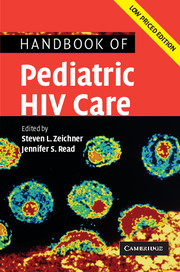Book contents
- Frontmatter
- Contents
- List of contributors
- List of abbreviations
- Foreword
- Preface
- Part I Scientific basis of pediatric HIV care
- Part II General issues in the care of pediatric HIV patients
- 3 Diagnosis of HIV infection in children
- 4 Prevention of mother-to-child transmission of HIV
- 5 Routine pediatric care
- 6 Emergency evaluation and care
- 7 Adherence to antiretroviral therapy in children and youth
- 8 Adolescents and HIV
- 9 Growth, nutrition, and metabolism
- 10 Neurobehavioral function and assessment of children and adolescents with HIV infection
- Part III Antiretroviral therapy
- Part IV Clinical manifestations of HIV infection in children
- Part V Infectious problems in pediatric HIV disease
- Part VI Medical, social, and legal issues
- Appendix 1 Formulary of antiretroviral agents
- Appendix 2 National Institutes of Health sponsored clinical trials for pediatric HIV disease
- Appendix 3 Selected HIV-related internet resources
- Appendix 4 Selected legal resources for HIV-infected children
- Index
- References
7 - Adherence to antiretroviral therapy in children and youth
Published online by Cambridge University Press: 23 December 2009
- Frontmatter
- Contents
- List of contributors
- List of abbreviations
- Foreword
- Preface
- Part I Scientific basis of pediatric HIV care
- Part II General issues in the care of pediatric HIV patients
- 3 Diagnosis of HIV infection in children
- 4 Prevention of mother-to-child transmission of HIV
- 5 Routine pediatric care
- 6 Emergency evaluation and care
- 7 Adherence to antiretroviral therapy in children and youth
- 8 Adolescents and HIV
- 9 Growth, nutrition, and metabolism
- 10 Neurobehavioral function and assessment of children and adolescents with HIV infection
- Part III Antiretroviral therapy
- Part IV Clinical manifestations of HIV infection in children
- Part V Infectious problems in pediatric HIV disease
- Part VI Medical, social, and legal issues
- Appendix 1 Formulary of antiretroviral agents
- Appendix 2 National Institutes of Health sponsored clinical trials for pediatric HIV disease
- Appendix 3 Selected HIV-related internet resources
- Appendix 4 Selected legal resources for HIV-infected children
- Index
- References
Summary
Improved health outcomes for HIV-infected children and youth will not be achieved without maximal viral suppression. Highly active antiretroviral therapy (HAART) represents a major breakthrough in HIV management, but not all patients respond optimally to HAART. Non-adherence is well established as a major cause of clinical failure, and intermittent non-adherence is a particular problem. Studies in adults have demonstrated that ≥95% adherence to HAART is necessary for durable suppression of viral load [1–3]. In the presence of selective pressure by antiretroviral agents, high rates of viral replication and viral mutation lead to the development of drug resistance. Mutations conferring resistance against one antiretroviral agent often confer cross-resistance to other agents; poor adherence can render a whole class of antiretroviral drug ineffective.
Although a crucial component of good clinical care, assessment of adherence to HAART in HIV-infected children and youth is challenging and labor intensive. Patient and parent (or other caregiver) characteristics associated with optimal adherence are not well characterized. Studies evaluating interventions to improve adherence in this group are encouraging but few.
HIV as a chronic illness
Pediatric HIV infection is now referred to as the “newest chronic illness in childhood” [4, 5]. Chronic illness alters a person's life by creating permanent changes in daily living. Adherence is a major problem in management of patients with any chronic illness. Non-adherence occurs with half of all medical recommendations made to chronically ill patients [6]. Chronic illness in children presents many unique adherence challenges.
- Type
- Chapter
- Information
- Handbook of Pediatric HIV Care , pp. 206 - 218Publisher: Cambridge University PressPrint publication year: 2006



